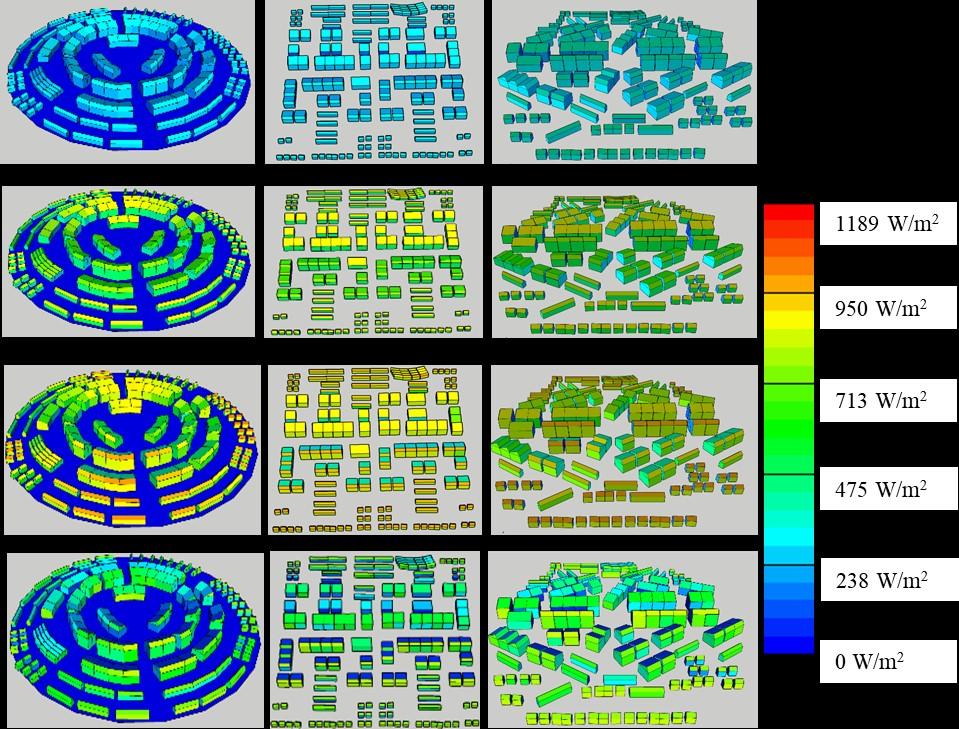
Neighborhood pattern analysis for street-network resilience and solar-radiation potential.
Courtesy Hachem-Vermette
June 22, 2021

Climate change will have serious impacts on cities and urban developments. While the term “ecosystem” doesn’t usually refer to a group of buildings, a researcher at the University of Calgary is passionate about new design strategies that could make communities more resilient and prepared for the future.
“Urban areas are negatively impacting the environment, and this impact is expected to intensify, given the worldwide rapid urbanization and projected increase in energy demand. On the other hand, due to their current design and operation, urban areas are highly vulnerable to natural disasters, as well as spread of pandemics," says Dr. Caroline Hachem-Vermette, PhD. "Climate-related disasters in Canada, such as ice storms (resulting in power outage), floods and wildfires have cost billions of dollars in damages and displaced hundreds of thousands of people.”
“This realization,” she continues, “and the importance and urgency of finding solutions to address this two-folded issue, motivates my efforts.”
Hachem-Vermette, an associate professor with the School of Architecture, Planning and Landscape, starts designing at the level of the neighbourhood.
As the design and construction industry continues to raise the bar for higher levels of sustainability, most new communities are planned and built with reduced environmental impact in mind. But what about those many places that were built before this type of thinking was common?
Hachem-Vermette’s research revolves not only around the design of new resilient communities, but also around existing ones, finding solutions inspired by these neighbourhoods. With an academic and research background in three distinct areas — architecture, urban planning and building engineering — she is a force of nature. Yet she somehow finds time for other pursuits, as she is also an exhibited artist. Through these multiple lenses, she brings a uniquely interdisciplinary approach to high-energy performance, low-carbon building designs, and interpolating these concepts at the city-scale — to provide practical, data-driven solutions for energy flow management.
“To address the issues of [the need for] increasing resilience and self-sufficiency of Canadian communities, while mitigating environmental impact, we are required to look at a two-pronged approach," says Hachem-Vermette. "The first is to understand the energy performance of existing, commonly designed neighbourhoods and their potential to integrate renewable and low-carbon energy sources. Simultaneously, we need to investigate the impact of innovative design strategies of buildings and neighbourhoods on energy and environmental performance, and on resilience, under various stressors.”
In support of this research, Hachem-Vermette was awarded a Natural Sciences and Engineering Research Council of Canada (NSERC) Discovery Grant — one of 34 UCalgary scholars to receive NSERC Discovery Grants as part of a major research investment by the federal government, announced earlier this month.
“NSERC Discovery Grants provide foundational support to our researchers as they explore novel, transformative ideas,” says Dr. William Ghali, vice-president (research). “Dr. Hachem-Vermette’s project is a stellar example of the kind of high-risk, high-reward research we are excited to see our NSERC Discovery Grant recipients pursue. We look forward to all that they will achieve with this support.”
One of Hachem-Vermette’s research objectives is to determine how to increase the energy performance and resilience of “building clusters.” From an energy operation standpoint, building clusters are defined as a group of buildings and surrounding outdoor areas connected to the same energy infrastructure.
“A database of building clusters is to be generated, based on simulation results, relating urban form with energy options and technologies. Examples of initial theoretical neighbourhood patterns are developed and analyzed in terms of the resilience of their street networks and their solar-radiation potential."

Neighborhood pattern analysis for street-network resilience and solar-radiation potential.
Courtesy Hachem-Vermette
Renewable energy solutions will include solar-integrated curtain walls developed by Hachem-Vermette as part of a previous Discovery Grant dedicated to advanced building envelope systems for improved energy performance of multi-storey buildings.

Advanced building envelope systems for improved performance.
Courtesy Hachem-Vermette
Not only does the research have the ability to shift decision-making about communities, both in the design construction sector as well in government, but if recommendations are implemented, it could also mean the creation of new manufacturing jobs in Canada.
“This research will indicate impacts of various urban-level design parameters, energy systems, and mix of energy sources on energy and environmental performance of neighbourhood archetypes. In addition to the economic and environmental benefits, it can provide an incentive for industrial developments based on innovative renewable energy technologies, opening opportunities for local employment.”
More immediately, the funding allows her to hire and extensively train master’s students and PhD candidates. These highly qualified personnel will also play key roles in government to shape new policies and incentive measures, and in universities to enhance research and education in related topics.
Highlights of Hachem-Vermette’s other research activities